Metamorphoses
The Metamorphoses (Latin Metamorphoses "transformations" or Metamorphoseon libri "books of transformations") by the Roman poet Publius Ovidius Naso, written probably around the year 1 AD to 8 AD, is a mythological poem written in hexameters about metamorphoses (ancient Greek μεταμόρφωσις metamórphosis "transformation into another form"). In 15 books of about 700 to 900 verses each, the story of the world is told from its beginnings to the poet's present, and is presented with great artistic wit in some 250 individual sagas from Roman and Greek mythology. From its appearance, the Metamorphoses is one of the most popular myth poems ever written and certainly the one best known to medieval writers and poets. The influence of this work on the literature of subsequent periods, as well as on the visual arts of the Middle Ages, the Baroque period up to that of modern times, is enormous.
The thematic core is the transformation motif frequently found in myths, in which a man or a lesser god is usually transformed into a plant, an animal or a constellation (katasterismos). The work begins with a proem, continues with the emergence of the world from chaos and ends with the transformation of Caesar's soul into a star, which is followed by an invocation to Augustus and an epilogue. The logical linking of the individual stories, which often do not belong together thematically, is achieved by means of transitions. Central stories and figures of mythology (e.g. Cosmogony, Heracles, Trojan War) are treated as well as more remote myths. Some metamorphoses are even only very briefly hinted at or mentioned in passing (e.g. Medea's flight over the Aegean in the seventh book).
Linguistically, the poem is characterized by a great narrative variation and a high artistic standard, so that, depending on the theme, elegiac, epic, tragic, comic or even grotesque tones can be heard. Because of this mixture of epic form, material variety and poetic elegance, the Metamorphoses are called an epic sui generis ("of its own kind").

The beginning of the Metamorphoses in the manuscript Biblioteca Apostolica Vaticana, Vat. lat. 1594, fol. 1r (15th century)
Content
In the following, the individual books are presented grouped in three pentads (ter quinque volumina). Each book is preceded by the opening verses in Latin and in a German translation. For individual figures, see also the list of figures in Ovid's Metamorphoses.
First pentad
Book 1 (779 verses)
In noua fert animus mutatas dicere formas,
corpora; di coeptis (nam uos mutastis et illa).
adspirate meis primaque ab origine mundiad
mea perpetuum deducite tempora carmen.
(Ov. met. 1,1-4)
To tell of the figures that once changed into new bodies,
so the spirit drives me. Ye gods, since ye have changed them,
Encourage my work, and let my song in perpetual flow From
the beginning of the world to my times!
- Prooemium/God's Call (verses 1-4)
- The creation of the world (verses 5-88)
- The four world ages (verses 89-150)
- The giants (verses 151-162)
- Lycaon (verses 163-252)
- The great flood (verses 253-312)
- Deucalion and Pyrrha (verses 313-415)
- Renewal of the animal world (verses 416-437)
- Python (verses 438-451)
- Daphne (verses 452-567).
- Io (verses 568-621)
- Argus (verses 622-688)
- Syrinx (verses 689-746)
- Phaethon (verses 747-779).
| Who/What | is being carried out by who/what | into whom/what | and why? |
| chaotic state (Chaos) | an indeterminate God | ordered world (Cosmos) | |
| Lycaon | Jupiter | Wolf | because Lycaon doubted Jupiter's divinity and put it to the test. |
| Stones (1, 383 ff. "Bones of the Mother") | Deucalion and Pyrrha | People | to repopulate the Earth after the great flood. |
| Daphne (Nymph) | Peneus | Laurel | Protection from the love-crazed Apollo, preservation of virginity |
| Syrinx (Nymph) | other nymphs ("her sisters") | Reed | to escape the pursuing Pan, preserve her virginity. |
| Io (Nymph) | Jupiter | Cow | to hide fling from Juno |
| Eyes of Argus | Juno | Eyes on the tail feathers of the peacock | as jewellery |
| Cow Io | Juno | Nymph Io | because Jupiter swore he'd never betray Juno again. |
Book 2 (875 verses)
Regia Solis erat sublimibus alta columnis,
clara micante auro flammasque imitante pyropo, ...
(Ov. met. 2,1-2)
Mighty rose the castle of Sol on lofty pillars,
Bright with gleaming gold and pyropus that shines like fire.
- Phaethon (verses 1-339)
- The Heliads (verses 340-366)
- Cygnus (verses 367-400)
- Callisto and Arcas (verses 401-530)
- Coronis (verses 531-588).
- Nyctimene (verses 589-632)
- Ocyrhoea (verses 633-675)
- Battus (verses 676-707).
- Aglauros (verses 708-759)
- Invidia (verses 760-832).
- Europe (verses 833-875)
| Who/What | is being carried out by who/what | into whom/what | and why? |
| light-skinned people, fertile areas, Waters | World conflagration caused by Phaethon | dark-skinned people, barren deserts... | because the sun chariot came too close to the earth |
| Heliads (Sisters of Phaethon) | Trees from whose bark amber drips | in mourning for Phaethon | |
| Cycnus (relative of Phaethon) | Swan | in mourning for Phaethon | |
| Callisto | Juno | Bear | Punishment for Callisto's connection with Jupiter |
| Callisto and her son Arcas | Jupiter | Constellations | to prevent the hunter Arcas from killing his mother. |
| White plumage of the raven | Apollo | Black plumage of the raven | as punishment for the raven betraying Coronis' infidelity. |
| Cornix | Minerva | Crow | to protect her from the wiles of Neptune. Preservation of virginity |
| Nyctimene | Bird | as punishment for incestuous relationship with the father | |
| Ocyroe | Mare | as punishment for ominous prophecies | |
| Battus | Mercurius | Stone | Punishment for Battus' perjury |
| Aglauros | Mercurius | stone monument | Punishment for Aglauro's envy of the relationship between Herse and Mercurius. |
| Jupiter | Taurus | to get close to Europe and kidnap her. |
Book 3 (733 verses)
Iamque deus posita fallacis imagine taurise
confessus erat Dictaeaque rura tenebat, ...
(Ov. met. 3,1-2)
And already the illusion of the bull had disappeared:
the deity had
revealed himself
and was dwelling in Dictes' realms, ...
- Cadmus (verses 1-130)
- Actaeon (verses 131-252)
- Semele (verses 253-315)
- Tiresias (verses 316-338)
- Narcissus and Echo (verses 339-510)
- Pentheus and Bacchus (verses 511-576)
- The Tyrrhenian skippers (verses 577-691)
- Pentheus' death (verses 692-733)
| Who/What | is being carried out by who/what | into whom/what | and why? |
| Teeth of the dragon slain by Cadmus | Warriors killing each other except for five survivors. | Creation of a new people | |
| Actaeon | Diana | Deer being torn apart by his own dogs. | Actaeon sees Diana naked |
| Juno | itself | Semele's nurse | to gain Semele's trust and give her some fateful advice. |
| Tiresias | into a woman and back into a man | for beating two copulating snakes with a stick. | |
| Narcissus | Nemesis | Daffodil | hopeless love of one's own reflection |
| Echo | Stone and echo | long loneliness due to hopeless love for Narcissus | |
| Tyrrhenian skippers | Bacchus | Delphine | Punishment for the abduction of Bacchus |
Book 4 (803 verses)
At non Alcithoe Minyeias orgia censetaccipienda
dei, sed adhuc temeraria Bacchumprogeniem
negat esse Iouis sociasque sororesimpietatis
habet.
(Ov. met. 4,1-4)
But Minya's daughter Alcithoe thought the god should be
denied worship: that Bacchus was Jupiter's son,
She does not yet believe, the blinded one, and the
sisters
share the wicked sentiment.
- The daughters of Minya (verses 1-54)
- Pyramus and Thisbe (1st daughter) (verses 55-166)
- Leucothoe and Clytia (2nd daughter) (verses 167-270)
- Salmacis and Hermaphroditus (3rd daughter) (verses 271-388)
- Transformation of the Minya daughters (verses 389-415)
- Athamas and Ino (verses 416-562)
- Cadmus and Harmonia (verses 563-603)
- Perseus (verses 604-620)
- Perseus and Atlas (verses 621-662)
- Perseus and Andromeda (verses 663-739)
- The Corals (verses 740-752)
- Medusa (verses 753-803)
| Who/What | is being carried out by who/what | into whom/what | and why? |
| pale fruits of the mulberry tree | the blood of Pyramus and Thisbe | dark fruit of the mulberry tree | |
| Sol | itself | Leucothoe's mother | to get close to Leucothoe and seduce her. |
| Leucothoe | Sol | Frankincense Bush | Living on after being killed by the father. |
| Clytie | Sunflower | out of unrequited love for Sol | |
| Salmacis and Hermaphroditus | a person of either sex | because Salmacis forces the union with Hermaphroditus. | |
| Minya daughters, their looms and weavings | Bats, vines and ivy vines | Bacchus | Punishment because the Minya daughters did not participate in the cult of Bacchus |
| Ino and her son Melicertes | Neptune at the request of Venus | the sea gods Leucothea and Palaemon | Rescue, after they had plunged into the sea - driven mad by Juno |
| Ino's companions | Juno | Stones and birds | Substitute for the failed revenge on Ino himself... |
| Cadmus and Harmonia | - | Snakes | at one's own request |
| Blood of the Gorgon Head | Snakes | ||
| Atlas | Gorgon Head | Mountain | Revenge of Perseus, because he did not receive hospitality from Atlas. |
| Sea Plants | Gorgon Head | Coral | |
| Hair of the Medusa | Minerva | Snake Hair | Punishment for the desecration of their temple |
Book 5 (678 verses)
Dumque ea Cephenum medio Danaeius herosagmine
commemorat, fremida regalia turbaatria
complentur, ...
(Ov. met. 5,1-3)
While the hero, the son of Danae,
tells such things in the circle of the Cephenes,
the hall of the king is filled with grim crowds;
- Perseus and Phineus (verses 1-235)
- Proetus and Polydectes (verses 236-249)
- Pallas and the Muses (verses 250-268)
- Pyreneus (verses 269-293)
- The Pierides in competition with the Muses (verses 294-317)
- Typhoeus (verses 318-331).
- Ceres and Proserpina (verses 332-358)
- Pluto and Proserpina (verses 359-384)
- Rape of Proserpina (verses 385-408)
- Cyane (verses 409-437)
- Stellio (verses 438-461)
- Ceres' further search and Arethusa's report (verses 462-532).
- Ascalaphus (verses 533-550)
- Sirens (verses 551-563)
- Iupiter's decision (verses 564-571)
- Arethusa's Narrative (verses 572-641)
- Triptolemus and Lyncus (verses 642-661)
- Transformation of the Pierids (verses 662-678)
| Who/What | is being carried out by who/what | into whom/what | and why? |
| Phineus and his warriors | Perseus (with the Gorgo) | Stone | Turning point in the fight at the wedding with Andromeda for the surrender of the bride |
| Proetus | Perseus (with the Gorgo) | Stone | Punishment for the expulsion of the brother |
| Polydectes | Perseus (with the Gorgo) | Stone | Punishment for insulting Perseus |
| Muses | itself | Birds | to free themselves from the grip of Pyreneus. |
| different gods and goddesses (Jupiter, Apollo, Bacchus, Diana, Juno, Mercurius) | itself | different animals (Ram, Raven, Buck, Cat, Cow, Ibis) | Typhoeophobia |
| Cyane | itself | Source | Grief because of the loss of Proserpina and anger because she could not stop Pluto's chariot |
| Stellio | Ceres (old woman's porridge) | Rock Lizard | Punishment for mocking Ceres |
| Ascalaphus | Proserpina | Eagle Owl | Punishment for treason: He indicated that Proserpina had eaten food in the underworld. |
| Daughters of Achelous | Gods | Sirens | |
| Alpheus, Arethusa | herself / Diana | River / (partly underground) spring | to better track Arethusa / to escape Alpheus |
| Lyncus | Ceres | Lynx | Punishment for attack on triptoloemus |
| The nine daughters of Pierus | the nine muses | nine magpies | Punishment for challenging the goddesses to the poetry contest |
Second pentad
Book 6 (721 verses)
Praebuerat dictis Tritonia talibus aurescarminaque
Aonidum iustamque probauerat iram.
(Ov. met. 6,1-2)
To these tales Tritonia listened gladly, praisingThe
Aonid's songs and her righteous indignation.
- Arachne (verses 1-145)
- Niobe (verses 146-312)
- Lycian peasants (verses 313-381)
- Marsyas (verses 382-400).
- Pelops (verses 401-411)
- Tereus, Procne, and Philomela (verses 412-674).
- Boreas and Orithyia (verses 675-721)
| Who/What | is being carried out by who/what | into whom/what | and why? |
| Athena | itself | old woman | to advise Arachne to beg forgiveness for her hubris... |
| On the carpet of Athena: Rhodope and Haemus, Gerana, Antigone, daughter of Cinyras | the first two by "the gods", all the others by Juno | mountains, crane, stork, stone steps at temple | Penalty for hubris |
| On the carpet of Arachne: Jupiter | itself | Taurus, Eagle, Swan, Satyr, Amphitryon, Golden Rain, Fire, Shepherd, Serpent | Abduction of Europa and Asteria, Seduction of Leda, Antiope, Alcmene, Danae, Aegina, Mnemosyne, Ceres |
| Neptune | itself | Bovine, Enipeus, Ram, Stallion, Bird, Dolphin | Seduction of Canace, procreation of Otos and Ephialtes, seduction of Theophane, Ceres, Medusa, Melantho |
| Apollo | itself | Farmer, Hawk, Lion, Shepherd | unspecified love relationships; as a shepherd seduction of the Isse |
| Bacchus | itself | Grapes | Seduction of the Erigone |
| Saturn | itself | Stallion | Procreation of Chiron |
| Arachne | Pallas Athene (Juices of Hecate) | Spider | Punishment for hubris, because she had challenged the goddess to a contest, but also out of pity, because Arachne wanted to hang herself |
| Niobe | Latona, Phoebus, Phoebe | Marble (stone spring on a mountain top) | Punishment for hubris, because she had boasted of her numerous children |
| Lycian farmers | Latona | Frogs (in the swamp) | Punishment for hubris, because they had denied the goddess access to the water |
| Tears of the lesser deities who mourn Marsyas | earth | Phrygian river Marsyas | survival in disguise |
| Philomela and Procne | - – | Nightingale and swallow | Rescue from the raging Tereus |
| Tereus | Hoopoe | Vindictiveness and grief for his slain son | |
| Calais and Zetes | hybrid bird-man | Alignment with her father Boreas |
Book 7 (865 verses)
Iamque fretum Minyae Pagasaea puppe secabant,
perpetuaque trahens inopem sub nocte senectamPhineus
uisus erat, ...
(Ov. met. 7,1-3)
On a Pagasian ship the Minyans had already sailed the sea,
And they had met Phineus, who
spent his old age
miserably in eternal night;
- Jason and Medea (verses 1-158)
- Aeson (verses 159-296).
- Medea's Revenge on Pelias (verses 297-349)
- Medea on the run (verses 350-403)
- Theseus and Aegeus (verses 404-452)
- Minos arms against Athens (verses 453-489)
- Cephalus at Aeacus (verses 490-500).
- Aegina on Athens' side (verses 501-516)
- Plague on Aegina (verses 517-660)
- Cephalus and Phocus (verses 661-670)
- Cephalus and Procris (verses 671-756)
- Laelaps (verses 757-793).
- Death of Procris (verses 794-865)
| Who/What | is being carried out by who/what | into whom/what | and why? |
| Dragon teeth Jason sows | Earth | Warriors attacking Jason | one of the tasks to obtain the golden fleece |
| Aeson, an old man (father of Iason) | a potion of Medea | a younger man | Postponement of natural death. Medea's proof of love for Jason |
| Wet nurses of Bacchus | Medea | young women | at the request of Bacchus |
| Oldest ram in the flock | Medea | Lamb | to prove to the daughters of Pelias that rejuvenation is possible. |
| Cerambus | Nymphs | Stag beetle | Rescue from the great flood |
| Snake | Apollo | Stone | to save the head of Orpheus... |
| Taurus | Bacchus | Deer | to cover up a cattle theft of his son (the legend is otherwise unknown) |
| Maera | Dog | ||
| Women of Kos | Venus | Cows | because they had challenged the goddess to a beauty contest... |
| Ctesylla, daughter of Alcidamas | Pigeon | ||
| Cygnus and his mother Hyrie | a swan and a lake | Rescue after jumping off a cliff / Mourning for the supposedly dead son | |
| Combe | Bird | Rescue from her sons, the Curets (the legend is otherwise unknown). | |
| King and Queen of Calaurea | Birds | ||
| Grandchild of Cephisus | Apollo | Seal | |
| Son of Eumelus | Apollo | Bird | |
| Mushrooms | Rain | People | |
| Foam from the three mouths of Cerberus | Earth | stinkweed | |
| Bones of the Sciro | Rocks | ||
| Arne | Jackdaw | Punishment for their greed for gold | |
| Ants | Jupiter | Myrmidon people | to repopulate Aegina after the plague... |
| Cephalus | Aurora | Man of other appearance | to test the loyalty of the Procris... |
| teumessian fox and Laelaps, the hunting dog of Cephalus | an indeterminate God | Stone | so that the race will end in a draw |
Book 8 (884 verses)
Iam nitidum retegente diem noctisque fugantetempora
Lucifero cadit Eurus et umida surguntnubila
;
(Ov. met. 8,1-3)
Lucifer hath now chased away the night, and unlocked the bright morning
; Eurus is settling, moist clouds are lifting
.
- Nisus and Scylla (verses 1-151)
- Labyrinth. Theseus and Ariadne (verses 152-182)
- Daedalus and Icarus (verses 183-235)
- Perdix (verses 236-259).
- Calydonian Boar (verses 260-444)
- Althaea (verses 445-525)
- The Sisters of Meleager (verses 526-546)
- Theseus at Achelous - Echinades and Perimele (verses 547-610)
- Philemon and Baucis (verses 611-724)
- Proteus (verses 725-737)
- Erysichthon and Mestra (verses 738-776)
- Fames (verses 777-842)
- Hypermnestra (verses 843-884)
| Who/What | is being carried out by who/what | into whom/what | and why? |
| Perdix | Pallas Athena | grey partridge | Rescue from deceitful death by Daedalus; punishment/bad conscience for Daedalus. |
| Perimele | Neptune | one island | Rescue from death |
| Philemon and Baucis | Jupiter | a lime tree and an oak tree | Fulfillment of a wish as thanks for hospitality |
Book 9 (797 verses)
Quae gemitus truncaeque deo Neptunius heroscausa
rogat frontis, cui sic Calydonius amniscoepit
, inornatos redimitus harundine crines:
(Ov. met. 9,1-3)
When the Neptunian hero asked the stream of Calydon,
What made him sigh why his brow was disfigured,
Spoke thus, a wreath of reeds in his shaggy hair:
- Achelous and Hercules (verses 1-97)
- Nessus (verses 98-133)
- Hercules Oeteus (verses 134-272)
- Galanthis (verses 273-323)
- Dryope (verses 324-393)
- Iolaus. The sons of Callirhoe (verses 394-453)
- Byblis (verses 454-665).
- Iphis (verses 666-797)
| Who/What | is being carried out by who/what | into whom/what | and why? |
| Achelous | he himself | first into a snake, then into a bull. | to stand up to Hercules in battle |
| Lichas | Hercules | Stone | Punishment; he brought Hercules the poisonous cloak |
| Galanthis | Lucina | Weasel | Because she tricked Iole into giving birth, which Lucina tried to prevent... |
| Byblis | - – | Source | she cries so much with grief because she loves her brother Caunus |
| Iphis | Isis | Man | so that Iphis, who was born a woman, could marry his beloved Ianthe... |
Book 10 (739 verses)
Inde per immensum croceo uelatus amictuaethera
digreditur Ciconumque Hymenaeus ad orastendit
et Orphea nequiquam uoce uocatur.
(Ov. met. 10,1-3)
But Hymenaeus escaped thence in saffron robeThrough the
infinite air: he strives for the land of the Cicones.
Demm it charges him the request of Orpheus: vain toil!
- Orpheus and Eurydice (verses 1-105)
- Cyparissus (verses 106-142)
- Ganymedes (verses 143-161).
- Hyacinthus (verses 162-216)
- Cerastae and Propoetides (verses 217-242)
- Pygmalion (verses 243-297)
- Myrrha (verses 298-502).
- Venus and Adonis (verses 503-559)
- Hippomenes and Atalanta (verses 560-707)
- Transformation of Adonis (verses 708-739)
| Who/What | is being carried out by who/what | into whom/what | and why? |
| Hyacinthus | Apollo | Flower | He was ashamed to have killed him. |
| Pygmalion's statue | Venus | a real woman | Venus takes pity and transforms the statue because Pygmalion has fallen in love with it. |
| Myrrha | Gods | Tree | She loved her father and wants to die, in life she would offend people, as dead people offend other dead people. |
| Hippomenes and Atalanta | Venus | Lions | Because Hippomenes did not thank Venus for her help, and he and Atalanta desecrated a sacred temple. |
Third pentad
Book 11 (795 verses)
Carmine dum tali siluas animosque ferarumThreicius
uates et saxa sequentia ducit, ...
(Ov. met. 11,1-2)
While the thracian singer
charms the wild animals with such songs
, the forests and rocks, so that they follow him, ...
- Death of Orpheus (verses 1-66)
- The Maenads (verses 67-84)
- Midas (verses 85-193)
- Laomedon and Hesione (verses 194-220)
- Peleus and Thetis (verses 221-265)
- Peleus' reception by Ceyx (verses 266-289)
- Daedalion and Chione (verses 290-345)
- The Wolf (verses 346-409)
- Ceyx and Alcyone (verses 410-748)
- Aesacus (verses 749-795).
| Who/What | is being carried out by who/what | into whom/what | and why? |
| Rice, stone, plaice, fruit, meat, grape juice | Midas (indirectly through Bacchus) | Gold | Bacchus grants Midas a wish as a reward for the recovered Silenus |
| Midas (under the curse of the gift of honour) | Bacchus | Midas (exempt from the gift of honour) | Bacchus takes pity and tells Midas how to wash away the guilt |
| Midas' Ears | Apollo | Dog-eared | Apollo pulls Midas' ears long as punishment and wraps them in grey fur |
| Thetis (goddess of water) | itself | Bird, Tree, Speckled Tigress | To protect herself from Peleus, who wishes to mate with her... |
| Morpheus (God of dreams) | itself | Ceyx | To tell Halcyone of the death of her husband Ceyx... |
| Ceyx and Halcyone | Gods | Birds (two kingfishers - Halcyoninae) | The couple separated by Ceyx's death can live together again |
| Aesakos (the diver) | Thetys | Bird | Thetys thus saves the diver from death, who wants to throw himself off the cliff out of guilt |
Book 12 (628 verses)
Nescius adsumptis Priamus pater Aesacon alisuiuere
lugebat; tumulo quoque nomen habentiinferias
dederat cum fratribus Hector inanes.
(Ov. met. 12,1-3)
Priam, without knowing that Aesacos lives as a winged being,
mourns the son. It donated Hector to the empty grave
- it bore only the name - the sacrifices, united with the brothers.
- The serpent in Aulis (verses 1-23)
- Iphigenia (verses 24-38)
- Fama (verses 39-63)
- Achilles and Cygnus (verses 64-168)
- Caeneus (verses 169-209).
- Lapiths and Centaurs (verses 210-535)
- Periclymenus (verses 536-579)
- Achilles' death (verses 580-619)
- Prelude to the Hoplon Crisis (Verses 620-628)
| Who/What | is being carried out by who/what | into whom/what | and why? |
| bluish snake | Stone | As a memorial to the prophecy of the seer Kalchas (9 years of war with Troy) | |
| Iphigenia | Diana | Doe | to save her from sacrifice |
| Cygnus | Neptune | Swan | to save him from being strangled by Achilles... |
| Caenis, a woman | Neptune | a man, Caeneus | to protect him in the future from rape and injury. |
| Caeneus the Man | Neptune | a yellow bird | to save him from suffocating under the fallen trees... |
| Periklymenos | Neptune | Eagle | to injure Hercules and then flee |
Book 13 (968 verses)
Consedere duces et uulgi stante coronasurgit
ad hos clipei dominus septemplicis Aiax, ...
(Ov. met. 13,1-2)
So the leaders sat, surrounded by the wreath of the people.
Aiax rose, the owner of the sevenfold shield;
- Hoplon Crisis: Speech of Aias (Verses 1-122)
- Hoplon crisis: speech of Ulysses (verses 123-381)
- Decision and suicide of Aias (verses 382-398)
- Philoctetes' return, conquest of Troy, Hecuba (verses 399-428).
- Polydorus (verses 429-438)
- Polyxena (verses 439-575)
- Memnon (verses 576-622).
- Aeneas' journey to Delos (verses 623-631)
- Anius (verses 632-674)
- Orion (verses 675-699)
- Onward journey of Aeneas (verses 700-729)
- Scylla (verses 730-749)
- Acis and Galatea (verses 750-897)
- Scylla and Glaucus (verses 898-968)
| Who/What | is being carried out by who/what | into whom/what | and why? |
| Akis | Sea Nymph Galateia, Faunus, Nymph Symaethis | river god with horns | The transformation saves Akis from the cyclops Polyphemus, who is jealous of him because of Galatea. |
| Glaucus | Oceanus, Tethys (sea gods) | Sea god with green hair and beard, bluish skin and a fish tail | Glaucus, after eating special grass on the beach, has a longing to live in the sea. Other sea gods desire his transformation. |
Book 14 (851 verses)
Iamque Giganteis iniectam faucibus Aetnenaruaque
Cyclopum quid rastra, quid usus aratri
nescia nec quidquam iunctis debentia bubusliquerat
Euboicus tumidarum cultor aquarum;
(Ov. met. 14,1-4)
And already the Euboean, dweller in the surging waters,Has
left the Aetna hurled at the giant's mawAnd the
Cyclopes' realms, which
owe nothing to karst and plough,
And nothing to the toil of ox-teams;
- Glaucus and Circe (verses 1-74)
- Continuing the journey of Aeneas (verses 75-88)
- Pithecusae (verses 89-100)
- Sibylla (verses 101-153)
- Achaemenides and Polyphemus (verses 154-222)
- Macareus and Circe (verses 223-307).
- Picus and Canens (verses 308-453)
- Diomedes and his companions (verses 454-511)
- The olive tree (verses 512-526)
- Aeneas' ships (verses 527-565)
- Ardea (verses 566-580)
- Aeneas' apotheosis (verses 581-608)
- The Kings of Alba Longa (verses 609-621)
- Pomona and Vertumnus (verses 622-697)
- Iphis and Anaxarete (verses 698-771)
- Lautulae (verses 772-804)
- Apotheosis of Romulus (verses 805-828)
- Hersilia (verses 829-851)
| Who/What | is being carried out by who/what | into whom/what | and why? |
| Scylla | Circe | Woman with angry hellhounds instead of an abdomen | Circe is jealous of Scylla because of Glaucus, who came to her to ask for a love potion for Scylla. |
| Sibylle | Apollo | a woman who lives a thousand years, but ages accordingly, so that in the end she exists only as a voice | When Apollo grants Sibyl a wish out of love, she wishes for a very long life, but forgets her equally long youth. Because she does not return Apollo's love, he does not add eternal youth of his own accord. |
| companions of Ulixes | Circe | Pigs, then people again | Transformation for no particular reason; re-transformation because Ulixes, who becomes her lover, demands it. |
| Aeneas | Jupiter, Venus, Numicius | God Indiges | After Aeneas' heroic life, Venus, his mother, asks Jupiter to make Aeneas a god. |
| Vertumnus | by itself | Men with different professions, an old woman, finally back into herself | To be near the beautiful tree nymph Pomona and win her over. She only falls in love with him immediately when he is himself again. |
| Romulus and his wife Hersilia | Jupiter, Juno | Gods Quirinus and Hora | Romulus' deification had long been promised to Mars by Jupiter and takes place after the latter has united the Latine and Sabine peoples. Juno takes pity on Hersilia, who mourns him. |
Book 15 (879 verses)
Quaeritur interea quis tantae pondera molissustineat
tantoque queat succedere regi;
(Ov. met. 15,1-2)
But one wonders who would be
able to carry such enormous burdens
, who would be able to follow such a powerful king.
- Numa (verses 1-11)
- Myscelus (verses 12-59)
- Pythagoras (verses 60-478)
- Egeria, Hippolytus (verses 479-551)
- Day (verses 552-559)
- Romulus' spear (verses 560-564)
- Cipus (verses 565-621).
- Aesculapius (verses 622-744).
- Apotheosis of Caesar (verses 745-851)
- Praise of Augustus (verses 852-870)
- Sphragis (Epilogue) (Verses 871-879)
| Who/What | is being carried out by who/what | into whom/what | and why? |
| Egeria | Artemis, Phoebus' sister | Source | to relieve her of her unquenchable grief over the loss of her husband Numa. |
| Caesar | Venus | Star | to help him live forever despite the assassination attempt. |
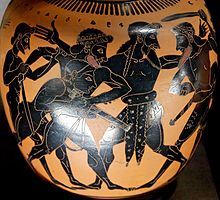
Aias and Odysseus quarreling over arms , Attic black-figure oinochoe by the Taleides painter, Louvre (c. 520 BC).
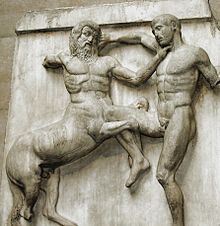
Fight of a Centaur with a Lapith, Metope of the Parthenon, British Museum, London
.jpg)
Anita Rée: Orpheus with the animals, mural in the ballet school of the Hamburg Ballet (around 1930)

Jean-Baptiste-Camille Corot, Orphée ramenant Eurydice des enfers (1861), The Museum of Fine Arts, Houston
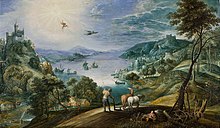
Marten Ryckaert, Landscape with a farmer plowing and the fall of Icarus (1620-1630), Wallraf-Richartz-Museum, Cologne
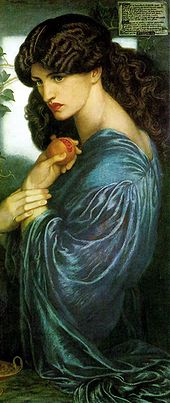
Proserpina , oil painting by Dante Gabriel Rossetti (1874)
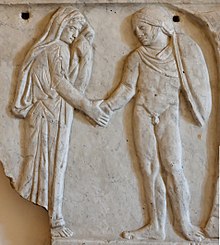
Jason and Medea join hands as a sign of their marriage covenant. Relief of a Roman sarcophagus of the 2nd century in Palazzo Altemps, Rome
_02_iniziale_I.jpg)
Beginning of the Metamorphoses in an Italian manuscript (ca. 1390)
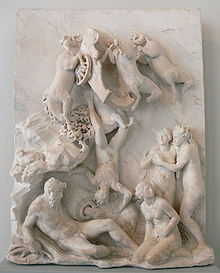
Simone Mosca, called Moschino: The Fall of Phaethon, 16th century (Bode-Museum Berlin)

Pyramus and Thisbe, mosaic in the so-called House of Dionysus (Paphos)
Issues
Critical text editions
- R. J. Tarrant (ed.): P. Ovidii Nasonis Metamorphoses. Recognovit brevique adnotatione critica instruxit R. J. Tarrant. Oxford University Press, Oxford 2004, ISBN 978-0-19-814666-7.
- W. S. Anderson (ed.): Ovidius. Metamorphoses. Reprint of the 2nd, improved edition of 1982. De Gruyter, Berlin 1998, ISBN 978-3-598-71565-5.
- Hugo Magnus (ed.): P. Ovidi Nasonis Metamorphoseon libri 15. Lactanti Placidi qui dicitur Narrationes fabularum Ovidianarum. Weidmann, Berlin 1914 (first critical edition, digital copy).
Bilingual editions
- Michael von Albrecht (ed.): Metamorphoses (Latin and German), Reclam, Ditzingen 1994, ISBN 3-15-001360-7 and further editions.
- Gerhard Fink (ed.): Metamorphoses. Das Buch der Mythen und Verwandlungen, Artemis & Winkler, Zurich/Munich 1989 and further editions.
- Niklas Holzberg (ed.): Publius Ovidius Naso. Metamorphoses. Latin - German. Translated into German hexameters by Erich Rösch. 14th edition. Artemis & Winkler, Zurich/Düsseldorf 1996.
Monolingual German editions
- Hermann Breitenbach (ed.): Publius Ovidius Naso, Metamorphoses. Epic in 15 books. With an introduction by L. P. Wilkinson. Reclam, Stuttgart 1986, ISBN 978-3-15-000356-5.
- without editor: Ovid Metamorphoses. In the transmission of Johann Heinrich Voß. With etchings by Pablo Picasso and an afterword by Bernhard Kytzler. Insel-Taschenbuch, Frankfurt am Main 2005, ISBN 978-3-458-32937-4.
Comments
- Alessandro Barchiesi (ed.): Ovidio. Metamorfosi. Fondazione Lorenzo Valla, Milan 2005-2015 (5 vols.).
- Franz Bömer: P. Ovidius Naso. Metamorphoses. Commentary. Winter, Heidelberg 1969-1986 (7 vols.).
- Franz Bömer, Ulrich Schmitzer: P. Ovidius Naso. Metamorphoses. Addenda, Corrigenda, Indices. Winter, Heidelberg 2006.
Audio books
- Ovid: Metamorphoses. Speaker: Peter Simonischek. Patmos Hörbuch, Düsseldorf 2006, ISBN 978-3-491-91199-4.
- Ovid: Metamorphoses. Narrator: Rolf Boysen. Audiobook (abridged reading). der Hörverlag, Munich 2007, ISBN 978-3-89940-587-3.
Questions and Answers
Q: Who wrote Metamorphoses?
A: Metamorphoses was written by Ovid.
Q: When was Metamorphoses written?
A: Metamorphoses was written about 1 AD to 8 AD.
Q: How many books are there in Metamorphoses?
A: There are 15 books in Metamorphoses.
Q: What is the length of each book in Metamorphoses?
A: The length of each book in Metamorphoses ranges between 700 and 900 verses of hexameters.
Q: What does Ovid describe in Metamorphoses?
A: In Metamorphoses, Ovid describes the history of the world as it was seen by Roman and Greek mythology.
Q: What kind of stories does Ovid select in Metamorphoses?
A: Ovid selects those stories in Metamorphoses which happened often, a lower deity or a human is changed into an animal, a plant, or a star.
Q: How does Metamorphoses start and end?
A: Metamorphoses starts with the beginning of the world, the flood. Only one couple survives the flood, Ducalion and Phyrrha. It ends with the change of the soul of Cesar into a star.
Search within the encyclopedia